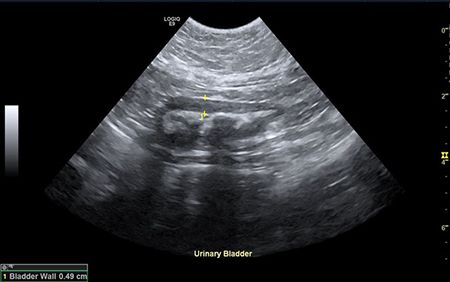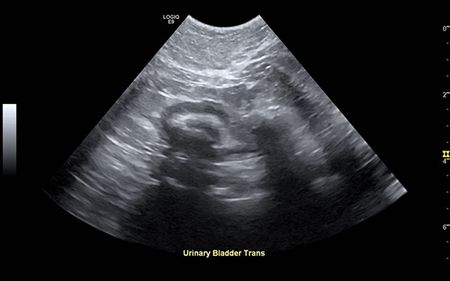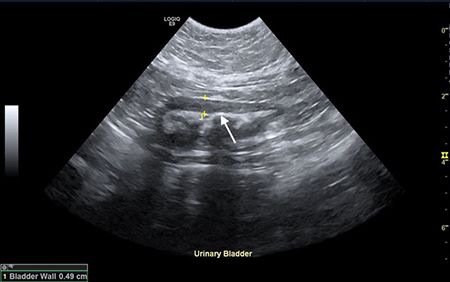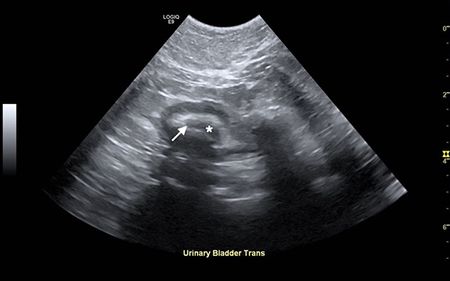Image Quiz: Help a cat's urinary tract get back on the right track
Examine the ultrasonograms, study the exam findings, and see if you can name the cause in this feline patient with hematuria and recurrent UTIs.
A 7-year-old male neutered domestic shorthaired cat presented for evaluation of chronic hematuria and recurrent urinary tract infections.
The back story
The cat had undergone a perineal urethrostomy surgery four years prior to presentation. Previously, the cat had developed a multi-drug-resistant Staphylococcus pseudintermedius infection that was cleared with chloramphenicol. Clinical signs consisting of hematuria, dysuria and stranguria began to recur four months prior to presentation and had shown only transient improvement with orbifloxacin, cefovecin, buprenorphine and robenacoxib.
Current findings
The results of a complete blood count and a serum chemistry profile were normal, and a urinalysis identified a urine specific gravity of 1.030, a pH of 8.5, marked cocci (> 40/hpf), 4+ magnesium ammonium phosphate crystalluria, > 100 RBCs/hpf and 10 to 15 WBCs/hpf.
Ultrasonographic findings:


Quiz time!
What is your diagnosis based on this history and ultrasonographic images of the urinary bladder?
The correct answer is b. Encrusting cystitis


Hyperechoic adherent mineral covering enter luminal mucosa (arrow). Asterisk denotes small lumen.The cat's urinary bladder is very small with minimal lumen present and the cranioventral wall is thickened, hypoechoic and irregular. There is mineral adhered to the surface of the entire urinary bladder wall. These findings are consistent with Corynebacterium-induced encrusting cystitis.
A direct urine culture yielded only Enterococcus faecalis, but a deep bladder wall culture yielded Enterococcus species, Escherichia coli, and Corynebacterium urealyticum. The cat was initially treated with chloramphenicol, but after becoming azotemic, he was hospitalized on intravenous fluids and amikacin (the only other available antibiotic options based on extended-spectrum culture), and underwent cystotomy for bladder wall débridement. Urinary signs resolved one week after surgery and remained resolved three months later.
Encrusting cystitis is a syndrome that is classically associated with urease-positive bacteria, primarily Corynebacterium urealyticum, which forms crusts and plaques of mineralized material on the mucosa of the urinary tract; alkaline urine and struvite crystals are typical findings on urinalysis.2 Radiographically, encrusting cystitis usually appears as a diffuse heterogeneous mineralization of the urinary bladder wall,2 and the ultrasonographic findings typically include diffuse urinary bladder wall thickening and non-gravity-dependent mineral debris, as observed in this case.1,2
C. urealyticum-induced encrusting cystitis is a rare but likely under-reported cause of severe lower urinary tract signs in cats.3 These infections tend to be resistant to many antibiotics, although most are at least intermediately susceptible to chloramphenicol and tetracycline and most are susceptible to enrofloxacin.1 This cat's previous perineal urethrostomy was likely a predisposing factor, as previous studies have reported that up to 25% to 30% of cats will develop urinary tract infections after surgery.4
Ultrasonographic identification of a diffusely thickened bladder with adherent mineralized material, a high pH, and struvite crystalluria should prompt an extended-duration culture for Corynebacterium species.
Jessica Romine, DVM, DACVIM, is a small animal internal medicine specialist at BluePearl Veterinary Partners in Southfield, Michigan. She has a special interest in interventional radiology and advanced imaging procedures.
References
1. Bailiff NL, Westropp JL, Jang SS, et al. Corynebacterium urealyticum urinary tract infection in dogs and cats: 7 cases (1996-2003). J Am Vet Med Assoc 2005;226:1676-1680.
2. Biegen VR, Slusser PG, Fischetti AJ, et al. Successful treatment of encrusted cystitis associated with Staphylococcus pseudintermedius infection in the urinary bladder of a dog. J Am Vet Med Assoc 2013;242:798-802.
3. Briscoe KA, Barrs VR, Lindsay S, et al. Encrusting cystitis in a cat secondary to Corynebacterium urealyticum infection. J Feline Med Surg 2010;12:972-977.
4. Osborne CA, Caywood DD, Johnston GR, et al. Feline perineal urethrostomy: A potential cause of feline lower urinary tract disease. Vet Clin North Am Small Anim Pract 1996;26:535-549.